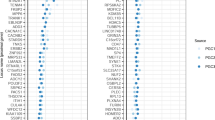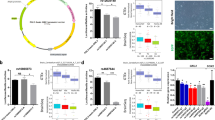Abstract
Several genome-wide association studies for bipolar disorder (BD) have found a strong association of the Ankyrin 3 (ANK3) gene. This association spans numerous linked single-nucleotide polymorphisms (SNPs) in an ∼250-kb genomic region overlapping ANK3. The associated region encompasses predicted regulatory elements as well as two of the six validated alternative first exons, which encode distinct protein domains at the N-terminus of the protein also known as Ankyrin-G. Using RNA ligase-mediated rapid amplification of cDNA ends to identify novel transcripts in conjunction with a highly sensitive, exon-specific multiplexed mRNA expression assay, we detected differential regulation of distinct ANK3 transcription start sites and coupling of specific 5′ ends with 3′ mRNA splicing events in postmortem human brain and human stem cell-derived neural progenitors and neurons. Furthermore, allelic variation at the BD-associated SNP rs1938526 correlated with a significant difference in cerebellar expression of a brain-specific ANK3 transcript. These findings suggest a brain-specific cis-regulatory transcriptional effect of ANK3 that may be relevant to BD pathophysiology.
This is a preview of subscription content, access via your institution
Access options
Subscribe to this journal
Receive 12 print issues and online access
$259.00 per year
only $21.58 per issue
Buy this article
- Purchase on Springer Link
- Instant access to full article PDF
Prices may be subject to local taxes which are calculated during checkout





Similar content being viewed by others
References
Craddock N, Sklar P . Genetics of bipolar disorder: successful start to a long journey. Trends Genet 2009; 25: 99–105.
Manolio TA, Brooks LD, Collins FS . A HapMap harvest of insights into the genetics of common disease. J Clin Invest 2008; 118: 1590–1605.
Baum AE, Akula N, Cabanero M, Cardona I, Corona W, Klemens B et al. A genome- wide association study implicates diacylglycerol kinase eta (DGKH) and several other genes in the etiology of bipolar disorder. Mol Psychiatry 2008; 13: 197–207.
Ferreira MA, O’Donovan MC, Meng YA, Jones IR, Ruderfer DM, Jones L et al. Collaborative genome-wide association analysis supports a role for ANK3 and CACNA1C in bipolar disorder. Nat Genet 2008; 40: 1056–1058.
Schulze TG, Detera-Wadleigh SD, Akula N, Gupta A, Kassem L, Steele J et al. Two variants in Ankyrin 3 (ANK3) are independent genetic risk factors for bipolar disorder. Mol Psychiatry 2009; 14: 487–491.
Sklar P, Ripke S, Scott LJ, Andreassen OA, Cichon S, Craddock N et al. Psychiatric GWAS Consortium Bipolar Disorder Working Group. Large-scale genome-wide association analysis of bipolar disorder identifies a new susceptibility locus near ODZ4. Nat Genet 2011; 43: 977–983.
Kordeli E, Lambert S, Bennett V . AnkyrinG. A new ankyrin gene with neural-specific isoforms localized at the axonal initial segment and node of Ranvier. J Biol Chem 1995; 270: 2352–2359.
Hopitzan AA, Baines AJ, Ludosky MA, Recouvreur M, Kordeli E . Ankyrin-G in skeletal muscle: tissue-specific alternative splicing contributes to the complexity of the sarcolemmal cytoskeleton. Exp Cell Res 2005; 309: 86–98.
Bennett V, Healy J . Organizing the fluid membrane bilayer: diseases linked to spectrin and ankyrin. Trends Mol Med 2008; 14: 28–36.
Pan Z, Kao T, Horvath Z, Lemos J, Sul JY, Cranstoun SD et al. A common ankyrin-G-based mechanism retains KCNQ and NaV channels at electrically active domains of the axon. J Neurosci 2006; 26: 2599–2613.
Mohler PJ, Bennett V . Defects in ankyrin-based cellular pathways in metazoan physiology. Front Biosci 2005; 10: 2832–2840.
Bennett V, Chen L . Ankyrins and cellular targeting of diverse membrane proteins to physiological sites. Curr Opin Cell Biol 2001; 13: 61–67.
Zhou D, Lambert S, Malen PL, Carpenter S, Boland LM, Bennett V . AnkyrinG is required for clustering of voltage-gated Na channels at axon initial segments and for normal action potential firing. J Cell Biol 1998; 143: 1295–1304.
Geiss GK, Bumgarner RE, Birditt B, Dahl T, Dowidar N, Dunaway DL et al. Direct multiplexed measurement of gene expression with color-coded probe pairs. Nat Biotechnol 2008; 26: 317–325.
Torrey EF, Webster M, Knable M, Johnston N, Yolken RH . The Stanley Foundation Brain Collection and Neuropathology Consortium. Schizophr Res 2000; 44: 151–155.
Huber W, Von Heydebreck A, Sültmann H, Poustka A, Vingron M . Variance stabilization applied to microarray data calibration and to the quantification of differential expression. Bioinformatics 2002; 18 (Suppl 1): S96–S104.
Bock C, Kiskinis E, Verstappen G, Gu H, Boulting G, Smith ZD et al. Reference maps of human ES and iPS cell variation enable high-throughput characterization of pluripotent cell lines. Cell 2011; 144: 439–452.
Roussos P, Giakoumaki SG, Georgakopoulos A, Robakis NK, Bitsios P . The CACNA1C and ANK3 risk alleles impact on affective personality traits and startle reactivity but not on cognition or gating in healthy males. Bipolar Disord 2011; 13: 250–259.
Ruberto G, Vassos E, Lewis CM, Tatarelli R, Girardi P, Collier D et al. The cognitive impact of the ANK3 risk variant for bipolar disorder: initial evidence of selectivity to signal detection during sustained attention. PLoS One 2011; 6: e16671.
Hatzimanolis A, Smyrnis N, Avramopoulos D, Stefanis CN, Evdokimidis I, Stefanis NC . Bipolar disorder ANK3 risk variant effect on sustained attention is replicated in a large healthy population. Psychiatr Genet 2012; 22: 210–213.
Linke J, Witt SH, King AV, Nieratschker V, Poupon C, Gass A et al. Genome-wide supported risk variant for bipolar disorder alters anatomical connectivity in the human brain. Neuroimage 2012; 59: 3288–3296.
Quinn EM, Hill M, Anney R, Gill M, Corvin AP, Morris DW . Evidence for cis-acting regulation of ANK3 and CACNA1C gene expression. Bipolar Disord 2010; 12: 440–445.
Roussos P, Katsel P, Davis KL, Bitsios P, Giakoumaki SG, Jogia J et al. Molecular and genetic evidence for abnormalities in the nodes of Ranvier in schizophrenia. Arch Gen Psychiatry 2012; 69: 7–15.
Dedman A, McQuillin A, Kandaswamy R, Sharp S, Anjorin A, Gurling H . Sequencing of the ANKYRIN 3 gene (ANK3) encoding ankyrin G in bipolar disorder reveals a non-conservative amino acid change in a short isoform of ankyrin G. Am J Med Genet B Neuropsychiatr Genet 2012; 159B: 328–335.
Villanueva R . The cerebellum and neuropsychiatric disorders. Psychiatry Res, advance online publication, 20 March 2012. [E-pub ahead of print].
Baldaçara L, Nery-Fernandes F, Rocha M, Quarantini LC, Rocha GG, Guimarães JL et al. Is cerebellar volume related to bipolar disorder? J Affect Disord 2011; 135: 305–309.
Soontornniyomkij B, Everall IP, Chana G, Tsuang MT, Achim CL, Soontornniyomkij V . Tyrosine kinase B protein expression is reduced in the cerebellumof patients with bipolar disorder. J Affect Disord 2011; 133: 646–654.
Stoodley CJ, Schmahmann JD . Evidence for topographic organization in the cerebellum of motor control versus cognitive and affective processing. Cortex 2010; 46: 831–844.
Schoenherr CJ, Anderson DJ . The neuron-restrictive silencer factor (NRSF): a coordinate repressor of multiple neuron-specific genes. Science 1995; 267: 1360–1363.
Ango F, di Cristo G, Higashiyama H, Bennett V, Wu P, Huang ZJ . Ankyrin-based subcellular gradient of neurofascin, an immunoglobulin family protein, directs GABAergic innervation at purkinje axon initial segment. Cell 2004; 119: 257–272.
Grubb MS, Burrone J . Activity-dependent relocation of the axon initial segment fine-tunes neuronal excitability. Nature 2010; 465: 1070–1074.
Kuba H, Oichi Y, Ohmori H . Presynaptic activity regulates Na(+) channel distribution at the axon initial segment. Nature 2010; 465: 1075–1078.
Grubb MS, Shu Y, Kuba H, Rasband MN, Wimmer VC, Bender KJ . Short- and long-term plasticity at the axon initial segment. J Neurosci 2011; 31: 16049–16055.
McQuillin A, Rizig M, Gurling HM . A microarray gene expression study of the molecular pharmacology of lithium carbonate on mouse brain mRNA to understand the neurobiology of mood stabilization and treatment of bipolar affective disorder. Pharmacogenet Genomics 2007; 17: 605–617.
Nanavati D, Austin DR, Catapano LA, Luckenbaugh DA, Dosemeci A, Manji HK et al. The effects of chronic treatment with mood stabilizers on the rat hippocampal post-synaptic density proteome. J Neurochem 2011; 119: 617–629.
Lang DG, Wang CM, Cooper BR . Lamotrigine, phenytoin and carbamazepine interactions on the sodium current present in N4TG1 mouse neuroblastoma cells. J Pharmacol Exp Ther 1993; 266: 829–835.
Acknowledgements
We gratefully acknowledge the Stanley Medical Research Institute (Maree Webster) for providing RNA and tissue samples from their postmortem human brain collection and the Massachusetts General Hospital Brain Bank (Charles Vanderburg) for generously providing postmortem human brain samples. Funding was provided by the Stanley Medical Research Institute and from the National Institute Of Mental Health (R33MH087896). The content is solely the responsibility of the authors and does not necessarily represent the official views of the National Institute Of Mental Health or the National Institutes of Health. We thank Drs Tracey Petryshen and Melanie Leussis for ongoing discussions and helpful review of this manuscript, and Leslie Gaffney for editorial assistance in preparing the figures for publication.
Author information
Authors and Affiliations
Corresponding authors
Ethics declarations
Competing interests
The authors declare no conflict of interest.
Additional information
Supplementary Information accompanies the paper on the Molecular Psychiatry website
Supplementary information
Rights and permissions
About this article
Cite this article
Rueckert, E., Barker, D., Ruderfer, D. et al. Cis-acting regulation of brain-specific ANK3 gene expression by a genetic variant associated with bipolar disorder. Mol Psychiatry 18, 922–929 (2013). https://doi.org/10.1038/mp.2012.104
Received:
Revised:
Accepted:
Published:
Issue Date:
DOI: https://doi.org/10.1038/mp.2012.104
Keywords
This article is cited by
-
Abnormal patterns of sleep and waking behaviors are accompanied by neocortical oscillation disturbances in an Ank3 mouse model of epilepsy-bipolar disorder comorbidity
Translational Psychiatry (2023)
-
Mapping the expression of an ANK3 isoform associated with bipolar disorder in the human brain
Translational Psychiatry (2022)
-
Roles and mechanisms of ankyrin-G in neuropsychiatric disorders
Experimental & Molecular Medicine (2022)
-
The role of microRNAs in diseases and related signaling pathways
Molecular Biology Reports (2022)
-
Homer1 promotes dendritic spine growth through ankyrin-G and its loss reshapes the synaptic proteome
Molecular Psychiatry (2021)



